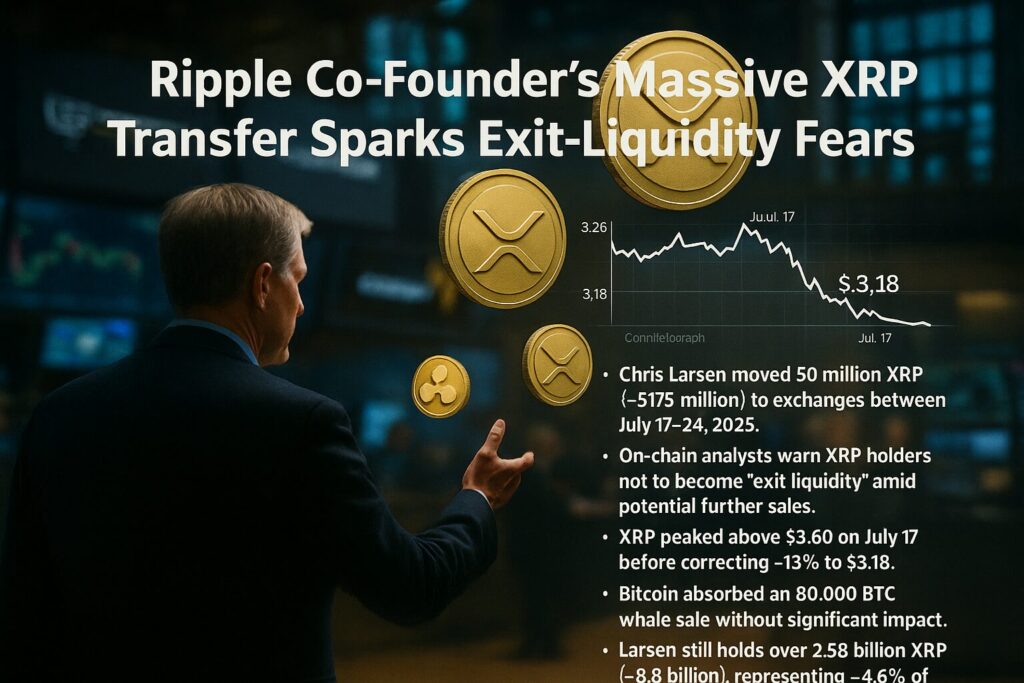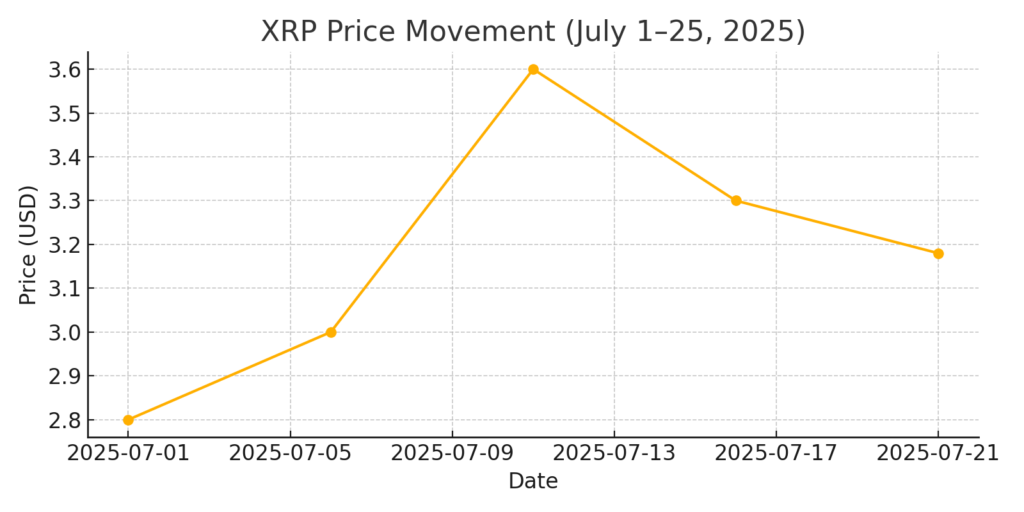
Main Points:
- Chris Larsen moved 50 million XRP (~$175 million) to exchanges between July 17–24, 2025.
- On-chain analysts warn XRP holders not to become “exit liquidity” amid potential further sales.
- XRP peaked above $3.60 on July 17 before correcting ~13% to $3.18.
- Bitcoin absorbed an 80,000 BTC whale sale without significant impact.
- Larsen still holds over 2.58 billion XRP (~$8.8 billion), representing ~4.6% of XRP’s market cap.
1. Chris Larsen’s Strategic Move: 50 Million XRP Transfer
Between July 17 and July 24, 2025, a wallet linked to Ripple co-founder Chris Larsen transferred a total of 50 million XRP—equivalent to roughly $175 million—to various addresses, of which about $140 million landed on centralized exchanges. Such on-chain movements are widely interpreted as precursor steps to liquidating large token holdings, fueling speculation of an impending sell-off.
2. Market Reaction and Community Sentiment
The crypto community’s response was split. Some investors viewed the transfers as routine profit-taking following XRP’s rally, while others accused Larsen of “dumping” tokens at peak prices. On social media, traders expressed concern that ordinary investors could be left holding the bag. This sentiment intensified after analytics contributor J. A. Maartunn warned followers on X (formerly Twitter) not to “get dumped on” by becoming exit liquidity.
3. The Analyst Perspective: Exit-Liquidity Concerns
CryptoQuant contributor J. A. Maartunn emphasized that, relative to Larsen’s remaining stash of over 2.58 billion XRP (worth about $8.83 billion), the recent $175 million movement was merely “a drop in the ocean.” He cautioned that if $200 million was the “warm-up,” larger sales could follow, potentially exerting significant downward pressure on XRP’s price.
4. XRP Price Performance Post-Transfer
XRP soared to an intraday peak above $3.60 on July 17, 2025, driven by broad altcoin market optimism. However, the large outflows coincided with a 13% retracement, bringing the price down to around $3.18 by July 25.
Insert Figure 1: XRP Price Movement (July 1–25, 2025) (position after this sentence)

The chart illustrates XRP’s rally in early July, its peak around mid-month, and subsequent pullback following the large token transfers.
5. Comparative Stability of Bitcoin Amid Whale Movements
In contrast, Bitcoin weathered an even larger whale movement without substantial price disruption. Data show an 80,000 BTC sale from a dormant Satoshi-era address in mid-July, handled by Galaxy Digital, briefly pushing BTC/USD down to $114,500 before a swift rebound. This resilience highlights Bitcoin’s deeper liquidity and wider institutional adoption relative to XRP.
6. Implications for XRP’s Long-Term Prospects
The episode spotlights ongoing centralization risks: a handful of large holders—or insiders—still control a significant share of XRP’s total supply. Investors may demand greater transparency around token unlocking schedules and vesting arrangements to better gauge potential sell pressure. Furthermore, Ripple’s partial legal victories and growing institutional interest in XRP (e.g., spot XRP ETF filings) could offset some negative sentiment, but only if large holders like Larsen signal stability rather than liquidation.
7. Looking Ahead: Potential Catalysts and Risks
- Ripple’s Legal Landscape: Continued progress in its SEC lawsuit may bolster confidence in XRP’s regulatory status.
- Institutional Demand: Uptick in spot XRP ETF applications could absorb some selling pressure.
- Whale Activity: Tracking on-chain whale wallets will remain crucial—any further large transfers could trigger renewed volatility.
- Macro Crypto Trends: Market-wide liquidity and risk-on/off dynamics will influence XRP’s ability to maintain gains.
Conclusion
Chris Larsen’s mid-July transfer of 50 million XRP has reignited concerns about exit liquidity and centralization risks within the XRP ecosystem. While the move coincided with a notable price pullback, XRP’s broader outlook will hinge on Ripple’s legal developments, institutional adoption (including potential ETFs), and the behavior of its largest holders. Investors should monitor on-chain analytics closely and remain prepared for further volatility, balancing profit-taking opportunities against the risks of large-scale token liquidations.

